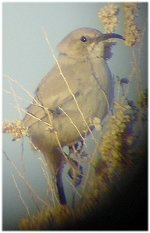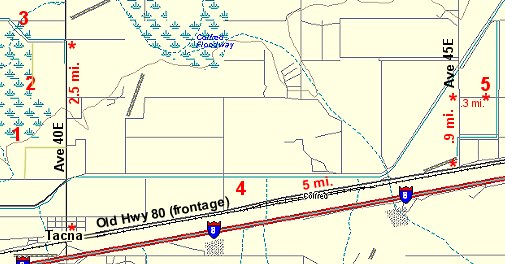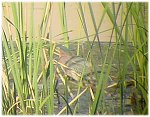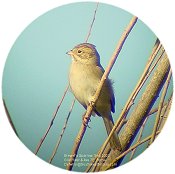
LeConte's Thrasher
|
Description
This area has a combination
of wetlands (Quigley Pond & the Gila River), agricultural
fields with weedy edges, and desert habitat. This
area is especially interesting to visit in the winter &
early spring, when you can find Prairie
Falcons, Ferruginous
Hawks, Northern Harriers, LeConte's
Thrashers, and a variety of
sparrows (White-crowned, Vesper, Savannah, Brewer's, Sage,
Lincoln's, Song, and
Lark). Migration brings passerines and shorebirds,
including Whimbrel and Long-billed Curlew.
Occasional Tundra Swans and White-fronted Geese
use Quigley Pond and the managed wetlands. Other waterfowl
are easy to see before and after hunting season. The Gila
River is attractive all year round, and provides great habitat
for White-faced Ibis, herons, egret, Cinnamon Teal, Vermilion
Flycatcher, and Blue Grosbeak. And be sure to check through any
little doves for Ruddy Ground-Doves, which winter in the area. |
Birding
Suggestions
(Numbered
spots correspond with the map on the right.)
1)
Quigley Pond
An
oxbow of the Gila River, this large marshy lake is best viewed
by driving north on Ave 40E for about a mile, and turning left onto a sandy road
(before Ave 40E drops off the bluff into the Gila River Valley). Drive
west about 1/2 mile on this sandy road, park, and walk to the
edge of the bluff. From here you may see raptors,
waterfowl, cormorants, and swallows. Depending on the time
of year, grebes, moorhens, and
rails call spontaneously, or respond to tapes.
2) AZ Game & Fish fields (Quigley Wildlife Management
Area)
These
fields can be viewed from the bluff overlooking Quigley Pond
(with a scope) or by walking in from the north (up to the
No-Trespassing sign). In past winters
Tundra Swans have made regular but brief visits; geese and waterfowl
are more common. Northern Harriers and other raptors
patrol the fields. 2 White-tailed Kites were here in the
winter of 2005-2006. Shorebirds are regular but hard to see
from the bluff. A large stand of cottonwoods and willows is
along the access road (just north of the farm fields).
Check this for abundant migrants in the late summer and early
fall, and for rarities like Dusky-capped Flycatcher (Dec 05).
3)
Gila River
The
shallow waters of the Gila River is regularly visited by
White-faced Ibis, egrets, herons, shorebirds, and waterfowl. A heron
rookery is about .5 miles south of the "ford" on
private property. In migration, look for warblers, vireos,
and flycatchers in the willows & cottonwoods. Drive
the Gila levee to see more habitat and
species.
4) Agricultural Fields
For several winters a Ferruginous Hawk and Prairie Falcon
have called this area home. These fields are often planted
with alfalfa, and have lots of weedy edges attractive to Vesper,
White-crowned, Brewer's, and Savannah Sparrows. Water
Pipits and Western Meadowlarks are also common.
5) Saltbrush Flats - Desert
During
February & March this can be a relatively easy place to see
singing LeConte's Thrashers. From Hwy 80, turn left (n.)
onto Ave 45E. Go about 1/4 mile past the farm complex and turn right on
an inconspicuous dirt/gravel road. This road had large
saltbrush flats that were good for the thrashers up until 2005,
when it was burned. Until they grow back, you'll need to
drive to the end of this road and bird the desert to the east,
where the thrashers perch in the mesquites to sing. This
is private land, but barren, and as of 2001, we've been given
verbal permission to look around.
|
Tacna
Area Map
Click
here for Overview Map

|
Red numbers
correspond to
the birding suggestions on the left
Blue
lines
are canals, blue grassy
spots are marshy areas
Rest rooms available at the Texaco in Tacna (Ave 40E and Hwy 80) |
|
|
|
Driving Directions to Tacna
Site #10 on the Yuma
County Map
Getting here from the intersection of 1st Street and 4th
Ave takes about 45 minutes:
- Drive north on 4th Ave
.2 miles and get onto I-8 eastbound.
- Drive east 40 miles on I-8 to the Tacna exit (Ave 40E).
- Drive north on Ave 40E about .25 miles to old Hwy 80 (just north of the
rail road tracks).
- Turn right to access the agricultural fields and the thrasher
site. Continue north to access Quigley Pond and the Gila River.
|
|
Possible
Bird
Sightings
-
unusual birds
highlighted in dark red
- (w)
indicates wintering bird
- (b) indicates breeding
bird
Migrants:
Warblers
-Hermit, Black-throated
Gray, Lucy's, MacGillivray's, Townsend's, Yellow-rumped (w), Wilson's,
Nashville, Orange-crowned (w)
-Common Yellowthroat (b,w)
Flycatchers
-Western Kingbird (b)
-Ash-throated Flycatcher (b,w)
-Willow Flycatcher (mid-May to mid-June)
-Western
Wood-Pewee
Other Migrants
- Northern
Harrier (w)
- Merlin (uncommon w)
- Cooper's & Sharp-shinned Hawks (w)
- Whimbrel
- Tundra Swan
- Black Tern
- all varieties of shorebirds
- western swallows (b,w)
- Lazuli Bunting
- Blue Grosbeak (b)
- Blue-gray Gnatcatcher (w)
- Black-tailed Gnatcatcher (b,w)
- Lesser Goldfinch (w)
- Leconte's
Thrasher (saltbrush)
- Crissal Thrasher (riparian
tangles/edges)
- orioles
- Lincoln's, W-C, Sage, Brewer's, and Vesper Sparrows (w)
Year-round
breeding Residents:
-
Pied-billed Grebe
- Common Moorhen
- American Coot
- Virginia
Rail & Sora
- herons
& egrets
- Turkey Vulture
- Owls: Western-Screech, Barn, & Great-Horned
- Red-tailed Hawk
- American Kestrel
- Spotted Sandpiper
- Greater Roadrunner
- Gambel's Quail
- Woodpeckers: Ladder-backed & Gila
- Loggerhead Shrike
- Say's and Black Phoebes
- Vermilion Flycatcher
- Great-tailed Grackle
- Black-tailed Gnatcatcher
- Verdin
- Song Sparrow
|
TRIP REPORTS
(Web Pages are Linked)
These pages give you some
idea of the birds that you can find in this location during the winter and
fall.
Birding
Trips
-
26
Nov 2000
- Quigley Pond, Ag fields, & Baker Tanks
-
24
Feb 2001 - trip with Paul Sherrell to search for LeConte's &
Bendire's Thrashers--success!
-
4
Apr 2001 - Yuma Birding Festival to Quigley Pond and Baker Tanks
-
3
Feb
2002
- morning trip with Aaron & Sharon to look at the LeConte's
Thrasher--it perched and sang several times.
-
10
Nov
2002
- quick trip out to the LeConte's Thrasher site with Anne &
Stuart--not the best time of year, but heard and saw one anyway!
-
21 Aug
2004 - looking for a reported Roseate Spoonbill, which we didn't
find--instead we saw literally hundreds of birds of all kinds of species
in the Quigley Pond Game Management Area. Vermilion & Willow
Flycatchers, Blue
& Black-headed Grosbeak, finches, sparrows, and warblers galore.
-
25 Dec 2005
- 3 Tundra Swans with assorted waterfowl in northern Quigley WMA farm
field, 2 White-tailed Kites, and a Dusky-capped Flycatcher in the
cottonwood grove north of the farm fields

Green Heron

Brewer's Sparrow
|
|